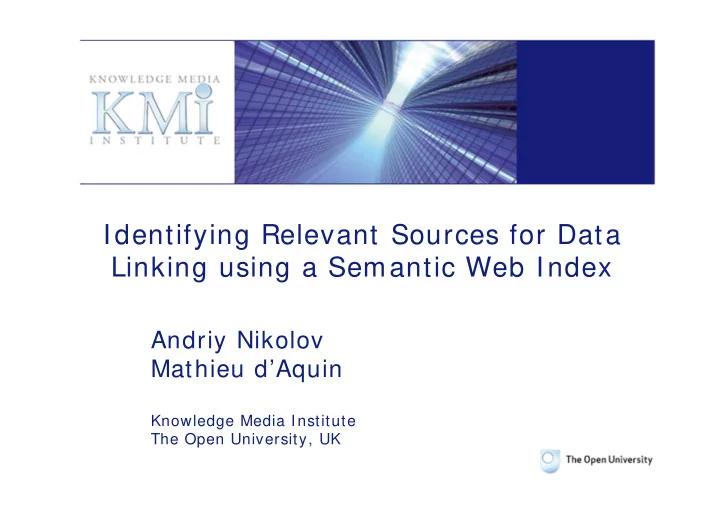

Identifying Relevant Sources for Data Linking using a Semantic Web Index Andriy Nikolov Mathieu d’Aquin Knowledge Media Institute The Open University, UK
How to link a new dataset? • What other repositories contain relevant data which I should link to? – Select the external repository • How to select the relevant data instances to link? – Select the relevant classes within the chosen repository ? LinkedMDB TV programs movies DBPedia pieces of music Freebase actors MusicBrainz composers bestbuy
Selection criteria • Additional information about local instances • Popularity • Degree of overlap DBLP data.open.ac.uk rae:RKBExplorer Publication data DBPedia
Available information • Additional information about resources – Schema ontology – Test examples • Popularity – VoiD descriptors • Linking repositories – Catalog of repositories (CKAN) • Degree of overlap – VoiD descriptors (only topic relevance) – Relevant info hard to obtain on the client side
Approach Search for sources with potentially high degree of overlap – Use a subset of entity labels from the original dataset as keywords for entity search
Approach Aggregate results – Group instances occurring in returned result sets by their source repositories
Approach Rank sources – Sort by number of individuals returned in search results
Approach Select “most relevant” class – Select the class in each source, which covers most of instances
Issues: imprecise results • Main cause: ambiguous instance labels • Inclusion of irrelevant sources – E.g., DBLP for movie score composers • Selection of inappropriate classes within the selected source – Too generic: e.g., dbpedia: Person vs dbpedia: MusicArtist – Irrelevant: e.g., akt: Publication-Reference (journal volume) vs akt: Journal
Filtering results Determine potentially irrelevant classes – Use state-of-the-art schema matching to select relevant classes
Filtering results Filter out irrelevant search results – Only consider search result instances belonging to “approved” classes
Preliminary experiments • Datasets – ORO journals (data.open.ac.uk): 3110 instances – LinkedMDB films: 400 instances – LinkedMDB music contributors: 400 instances • External components – Semantic index: Sig.ma – Ontology matching techniques: CIDER, instance-based schema mappings retrieved from BTC2009 dataset
Preliminary experiments • Performance measure: – Proportion of relevant sources among the top-10 returned results Before filtering + / - After filtering + / - rae2001 (RKB) + rae2001 (RKB) + dotac (RKB) + DBPedia + DBPedia + dblp.l3s.de + oai (RKB) + Freebase + dblp.l3s.de + DBLP (RKB) + wordnet (RKB) - eprints (RKB) + bibsonomy - eprints (RKB) + Freebase + www.examiner.com -
Preliminary experiments • Summary: – Top-ranked returned repositories are largely relevant from the point of view of linking – Filtering using schema matching techniques greatly improves precision (all remaining sources are relevant) – … but at the expense of some recall
Future work • Improving the quality of results – E.g., estimating the potential loss of precision/ recall for different filtering decisions • Integrating with the data linking workflow – Automatically pre-configuring the data linking algorithm • Repository search as a potentially useful semantic search use case (in addition to entity and document search)
Thanks for your attention Questions?
Recommend
More recommend